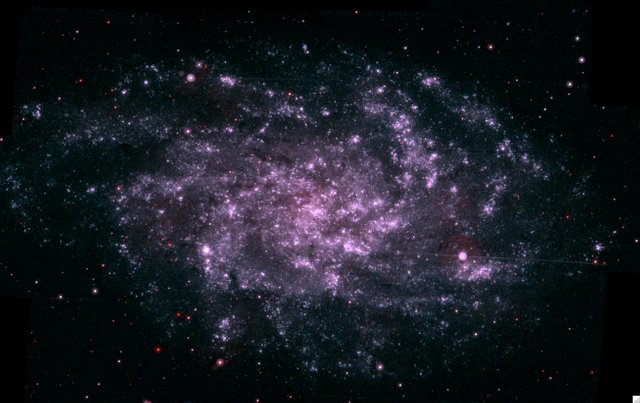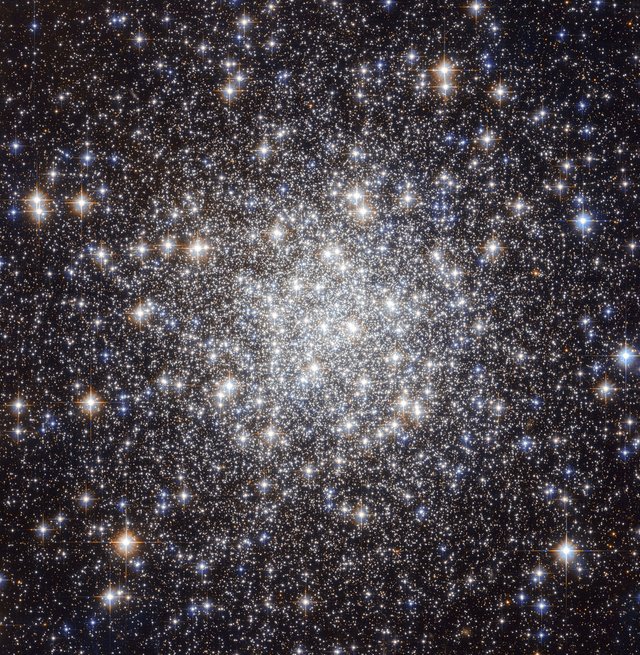Dark matter, the hidden mass of the universe
Dark matter is the Mysterious Substance That Binds the Cosmos Together, What and Where is it?
The Evidence is Growing
We have many pieces of evidence from the colliding of star clusters to the rotation of galaxies. The only problem we have had is actually detecting it.
The Evidence
Galaxies rotate faster than should be possible. The centripetal force should rip them apart (or at least throw most of the stars on the outside away into intergalactic space). We can observe this using the Doppler Effect. The Doppler Effect allows us to observe a change in light based on if an object is moving closer or farther from us. (The Doppler Effect is when a wave looks stretched out or compressed because the source is moving away or closer to us.) If the Doppler Effect is used with a high resolution photo of a galaxy we can observe its rotation, star cluster collisions not following the paths we would expect the matter to go, and large differences between the amount of rotation and the mass of the galaxies. In star cluster collisions the matter did not directly attract and go the paths we expected. This could be explained by a particle that does not interact much trailing behind them. The differences between what we have observed with galaxies and what we measure could be explained if there is large amounts of dark matter in a halo around each galaxy. Estimating the amount of mass is just as easy as the rotation with the right tools. We just need the light it produces, we did not find enough mass to keep to keep the galaxy together.
(citation)
(source)
More Definitive Proof on the Rotation of Galaxies
Galaxies are some of the biggest structures in the universe and each one varies a lot from the next. A group studied 153 galaxies with 2693 measurements total. This was done on flatter and more spiral like galaxies. Spiral galaxies were used because it is far easier to measure the rotation in more two dimensional objects, and they are easier to treat as a flat plane then other galaxy shapes. Measuring the light of stars at near infrared levels allows an accurate estimate of stars mass. They then measured the amount of hydrogen, using the light spectrum it gives off, to estimate the amount of gas. We know how common helium and other elements should be compared to hydrogen. They then added this together to estimate the mass of the galaxies. It fell short for large and small galaxies alike. It was found that the rotation around the edges was faster than should be possible without something holding it together or a modification of gravity. We have made simulations of dark matter in galaxy formation and rotation, but have not gotten it accurate to what we see today. We think the dark matter is in halos around galaxies, but that is not always what happens in simulations. This discrepancy has caused different theories to become popular, including MOND. MOND is a modification to the theory of gravity. It is applied when there are extremely small amounts of gravity, like between very distant objects. MOND is one of the opposing theories to dark matter. It can explain a lot but also leaves a lot unexplained.
(citation)

(source)
We Have Many Ongoing Efforts to Observe Dark Matter
We have gone through major efforts to create or at least observe dark matter. Yet sadly, we have only found where and what dark matter probably is not. Based upon our observations dark matter should be 6 times more massive than regular matter, but that doesn’t seem to make it easier to observe. We can only see the effects of it through gravity.
We use the electromagnetic spectrum for almost everything, from computers to sight. Detecting something that does not interact with it can be a challenge, even if it should be about 27% of the universe. We can use other ways to detect them, for example observing missing mass and energy. If they are light enough to be made in the LHC, they would escape past the detectors unnoticed. However, mass that is expected to be there after the collision would be missing. To find the collision that produced it is like trying to find a hay in a needle stack, that you can't be sure is there until you've found it. The LHC makes a massive amount of data and analyzing it is a hard process. (Making and processing simulations is an ongoing process and a member of steem and has posted a call to arms here.) Most explanations of dark matter lie beyond anything we have found today. From "hidden valleys" of a dark matter in parallel dimensions to supersymmetry and higher dimensions. If it is supersymmetry we may be able to observe it. If it is not we will need far more complicated tools.
(ciation)
WIMP the Most Common Theory
They are thought to be a WIMP (Weakly Interacting Massive Particle) of some type. We have tried to observe if they ever naturally run into atoms. A giant underground tank full of 72,000 gallons of pure xenon was set up and cooled. Light sensors were set up all around it to see if a flash of light could be detected if dark matter ran into an atom of xenon. Unfortunately, nothing was observed. This could mean a few things: it is extremely massive and is not common enough to hit within the two year period they did it, or it is not a WIMP.
(citation)
The search continues.

(source)
We Have Tried to Explain it in Many Ways, But Not All Are Satisfied
MOND or modified Newtonian dynamics is a theory that doesn’t need dark matter. At extremely small accelerations Newtonian physics, it states, is incorrect. It introduces a new cosmological constant that is only applied under these conditions. It can explain the rotation of galaxies, but cannot explain other evidence, like the movement of star clusters when colliding.
There is also the observation of gravity coming from "shadow" dimensions. We have our three dimensions of space and one of time. We may have another dimension that could be like time or space that we can't interact with. We have no way to prove or disprove that with our current equipment. It could be particles, like ours or different it does not matter, in a higher dimension where gravity "leaks" through and affects ours. There are also some non-particle dark matter ideas by NASA (If you are a hammer everything looks like a nail). They could be brown dwarfs (failed stars), white dwarfs, black holes or neutron stars. However, there are likely to enough of them to make it a feasible option. One of the more popular (but unlikely) scenarios are primordial black holes. Made during the big bang and shooting through space unobserved. No light comes from them and they could be small and numerous. We have not observed much in the way of this theory and is untested. They would slowly radiate away over time. This would mean we should see the effects of it becoming less over time. We have simply not observed enough galaxies in detail to prove or disprove this.
If you have enjoyed this article please consider following me @anarchyhasnogods for more! Thank you for supporting my work!


Very nice post and very complete! I really like it!
The way used to detect the invisible at the LHC is actually a bit more complicated. In short, in the case you have a collision only producing dark matter, from a detector standpoint it produces nothing and is thus not recorded. One indeed needs to trigger the detectors for a collision to be recorded. Two of my last three publications actually concern this topic. If interested, I could write a post about that ^^
Concerning MOND theories, we now also have hybrid dark-matter/MOND theories on the market which seem to accommodate data better.
So, dark matter is essentially what scientists made up because the way the universe moves didn't fit their equations, right?
what do you mean by made up?
Well, if you want to use a fancy word, you could say "theorized"?
Dr. Oort - "Crap, these equations don't add up! We must be missing something!"
Dr. Zwicky - "Well then there must be some stuff that we can't see or detect floating around in space, too. Our equations can't be wrong!"
MOND goes on the equations are wrong. All evidence points to a particle or mass we can not detect. I walk into a room, see a cup has moved since yesterday. Did I make up that the cup must have been moved?
No, but saying "the cup moved because of this concept I created. I must look for the concept." seems a bit ridiculous to me.